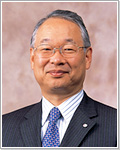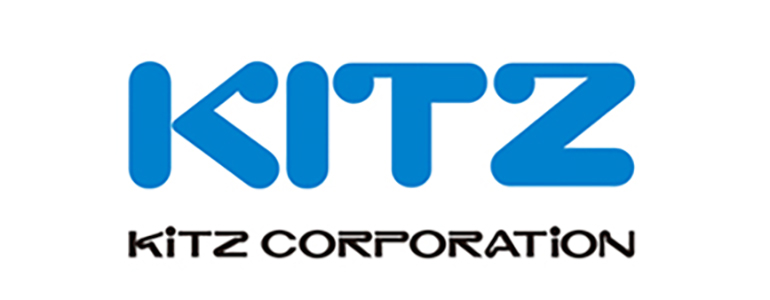| KITZ (6498) |
|
||||||||
Company |
KITZ CORPORATION |
||
Code No. |
6498 |
||
Exchange |
TSE 1st Section |
||
Industry |
Machinery (Manufacturing) |
||
President |
Yasuyuki Hotta |
||
HQ Address |
1-10-1 Nakase, Mihama-ku, Chiba, 261-8577, Japan |
||
Year-end |
March |
||
URL |
|||
* Share price as of closing on May 25. Number of shares outstanding as of most recent quarter end do not include treasury shares.
|
||||||||||||||||||||||||
|
|
* Estimates are those of the Company.
Mail: kitz@cyber-ir.co.jp |
|
| Key Points |
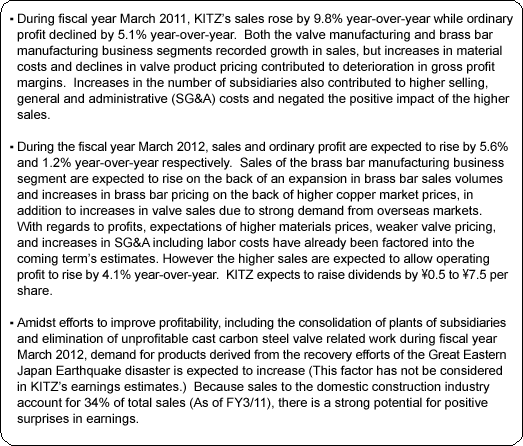 |
| Company Overview |
|
(Overview of KITZ's Business Segments)
KITZ's business is divided into the valve manufacturing, brass bar manufacturing and other business segments. During fiscal year March 2011, each of these divisions accounted for 72%, 19% and 9% of total sales respectively.
Valve Manufacturing Business
The KITZ Group's core business is the manufacture and sale of valves, connectors and other fluid control devices that play important roles in fresh and sewage water distribution, water heating, gas supply, and air conditioning applications, as well as in various applications within the petroleum, chemical, paper and pulp, semiconductor and other industries.
Brass Bar Manufacturing Business
In the brass bars business KITZ combines copper with zinc to create brass, tin and phosphorous to create phosphor bronze, and nickel and zinc to create nickel silver, which are then used in the dissolving, casting, rolling, pulling, forging, heating, and forming processes to create sheets, strips, pipes, bars, wires and other forms. The KITZ Group's brass bar business uses the raw material of brass to manufacture and sell brass bars. These brass bars are used not only as materials for valves, but also in the manufacture of water faucets, gas equipment, electrical appliances and other various products.
Other
KITZ operates sports and fitness clubs, hotels and restaurants, and sells glass art work in its services.
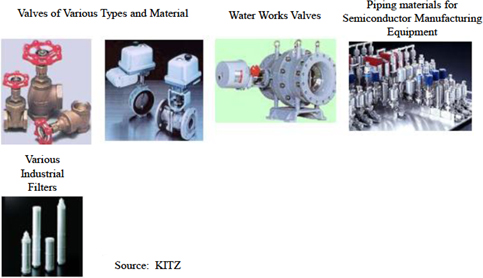 |
| Fiscal Year March 2011 Earnings Results |
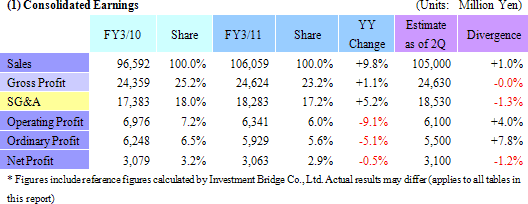 Sales Rise 9.8%, Ordinary Profit Fall 5.1%
Sales rose by 9.8% year-over-year to ¥106.05 billion. Increases in both demand and pricing of brass bars allowed brass bar manufacturing sales to rise, along with growth in valve manufacturing business sales on increased demand from both overseas and domestic markets. However higher materials prices and lower valve pricing compounded by the stronger yen and contributed to a 2.0% point deterioration in gross profit margins to 23.2%. However increases in SG&A costs accompanying the consolidation of PERRIN GmbH of Germany (Duesseldorf) could not be covered by the higher sales, subsequently operating profits declined by 9.1% year-over-year. At the same time reductions in interest bearing liabilities (Reduced from ¥600 to ¥460 million) allowed non-operating balance to improve. Reductions in impairment accounting losses and additional retirement benefits contributed to a decline in extraordinary losses and allowed net income to decline by a smaller margin of 0.5% year-over-year. A dividend payment of ¥4 per share is expected to be paid to shareholders as of the term end, combined with the midterm dividend for a full year dividend payment of ¥7 per share.Furthermore, ¥390 million in losses from implementation of asset retirement obligation accounting standards and ¥490 million from fixed asset impairment losses contributed to a total extraordinary loss of ¥1.1 billion, which compares with the impairment loss of ¥1.17 billion and total extraordinary loss of ¥1.76 billion recorded during the previous fiscal year. KITZ assumptions for foreign currency called for an exchange rates of ¥87.32 per US Dollar, (Actual rate of ¥93.71 in the previous term), and ¥115.06 per Euro (Actual rate of ¥130.51 in the previous term). Also the Company used a price assumption of ¥740,833 per ton (¥620,000 per ton in the previous term) for electrolytic copper. 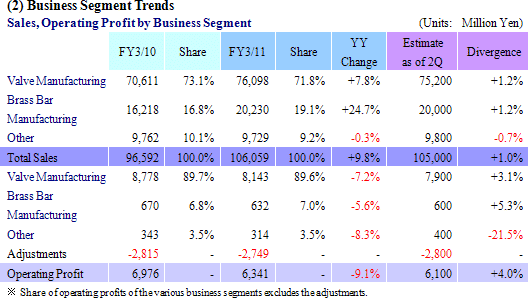 Valve Manufacturing Business
Sales rose by 7.8% year-over-year to ¥76.09 billion. Domestic sales grew by 5.4% year-over-year to ¥54.05 billion. Sales to petroleum refining, petrochemical, and fresh and sewage water applications declined, while sales to construction facilities, machinery related, and semiconductor related applications (Sales to semiconductor related applications rose by 84% year-over-year to ¥6.1 billion) rose. At the same time overseas sales rose by 14.0% year-over-year to ¥22.04 billion. Sales to applications in the petroleum refining and petrochemical declined, causing North America sales to fall by 18% year-over-year to ¥5.8 billion. Sales to Europe rose by 3% year-over-year to ¥3.5 billion, and favorable sales of general use valves to construction facilities contributed a 76% year-over-year growth in sales to Thailand, Indonesia, China and other Asian markets to ¥12.3 billion.Operating profits of the valve manufacturing business segment declined by 7.2% year-over-year to ¥8.14 billion. While there were some positive effects from the higher sales and efforts to reduce costs, they could not offset higher materials prices, declines in product pricing, and higher SG&A costs arising from the consolidation of PERRIN GmbH. By product, profitability of brass, bronze and stainless steel valves increased, while profitability of cast carbon steel valves deteriorated. Brass Bar Manufacturing Business
Increased demand for brass bars and rises in product prices accompanying sharp increases in the copper market allowed sales to rise by 24.7% year-over-year to ¥20.23 billion. Despite the higher sales and reductions in expenses, reductions in translation gains in materials contributed to a 5.6% year-over-year decline in operating profit to ¥630 million.
Other
Due in part to the Eastern Japan Earthquake and Tsunami disaster that struck Japan on March 11, sales of the other business segment declined by a marginal 0.3% year-over-year to ¥9.72 billion (The disaster acted to depress fitness club and hotel businesses sales by ¥62 and ¥60 million respectively.) and operating profit fell by 8.3% year-over-year to ¥310 million. Furthermore the fitness club business was able to record increases in both sales and profits on a year-over-year basis due to the full year contribution of new facilities opened in the previous term and despite temporary closure of two facilities in the disaster affected region of Sendai and Mito. At the same time large cancellations in hotel reservations contributed to declines in both sales and profits, and the Suwa Garasu Koubou Co., Ltd. recorded an operating loss on the back of lower sales.
(3) Group Company Business Trends
Looking at individual companies within the KITZ Group, the parent company KITZ recorded 5.3% year-over-year growth in sales to ¥51.0 billion, and a 19.3% year-over-year decline in ordinary profit to ¥2.91 billion. While higher materials costs and lower product pricing contributed to this decline in profits, this performance was basically in line with expectations. Toyo Valve Co.,Ltd, the main subsidiary in the valve business, saw growth in both sales and profits, but Shimizu Alloy Mfg.Co.,Ltd, recorded declines in both sales and profits. KITZ SCT Co., Ltd., the main subsidiary in semiconductor manufacturing equipment related applications, recorded strong sales growth of 1.8 times year-over-year, and its operating profit recovered from losses in the previous term to slightly less than ¥700 million. Amongst its overseas subsidiaries, KITZ Corporation of Jiangsu Kunshan, which provides cast carbon steel valves for petroleum refining and petrochemical applications, recorded low profitability projects and therefore saw a large decline in profits (Conditions are currently improving.). Also the stronger yen and economic weakness in the European market caused PERRIN GmbH to record an operating loss. KITZ Metal Works Corporation, which manufactures and sells brass bars, saw an increase in sales while operating profits declined on the back of lower material price translation gains.
 Brass bar manufacturing business product demand improved and product pricing rose during the fourth quarter. With regards to profits, the impact from fluctuations in the copper market was negligible and profitability was achieved during the fourth quarters. The other business normally sees a higher amount of its sales and profits in the first half of the fiscal year due to seasonal factors arising from its fitness club and hotel operations (Weaker demand for both occur during the winter season.), but the occurrence of the Eastern Japan Earthquake and Tsunami disaster accentuated this seasonality. (5) Financial Conditions and Cash Flow
Total assets as of the end of the term rose by ¥2.6 billion from the end of the previous term to ¥100.13 billion. To prepare for the maturing of ¥6.0 billion in corporate bonds in October 2011, a bond was issued for a total of ¥6.0 billion, which caused cash and equivalents and interest bearing liabilities to increase. With regards to cash flow, increases in working capital arising from the higher sales caused operating cash flow to decline. At the same time declines in payments for M&A related activities caused the net outflow in investing activities to decline. Consequently free cash flow declined from the previous term to ¥2.91 billion, and cash and equivalents grew by 30.4% from the previous term end to ¥12.7 billion.
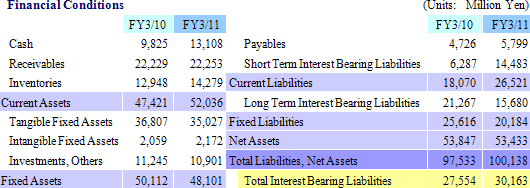  |
| Fiscal Year March 2012 Earnings Estimates |
 Sales and Ordinary Profit Expected to Rise by 5.6% and 1.2%
KITZ calls for sales to rise by 5.6% year-over-year to ¥112 billion during fiscal year March 2012. Sales of the valve manufacturing business are expected to rise primarily on the back of strong sales to overseas markets. At the same time brass bar manufacturing business sales are also expected to grow on the back of strong demand for brass bars and higher product prices accompanying strength in the underlying copper market. With regards to profits, reductions in costs and the effects of economies of scale are anticipated to be accompanied by higher materials pricing and lower product pricing (The impact of both factors are expected to fall to roughly half of what they were in FY3/11.) and gross profitability is expected to decline by 0.1% point year-over-year. While increases in variable costs and personnel are also expected to boost selling, general and administrative costs, higher sales are expected to negate some of the impact of these factors and allow operating profit to rise by 4.1% year-over-year to ¥6.6 billion. Financial income is expected to decline and non-operating income is expected to deteriorate. However extraordinary losses are expected to fall and net profit is expected to grow by 4.5% year-over-year to ¥3.2 billion. KITZ projects a ¥0.5 increase in dividends to ¥7.5 per share.KITZ assumptions for foreign currency call for an exchange rates of ¥81.00 per US Dollar, (Actual rate of ¥87.32 in FY3/11), and ¥113.00 per Euro (Actual rate of ¥115.06 in FY3/11). Also the Company uses a price assumption of ¥820,000 per ton (¥740,833 per ton in FY3/11) for electrolytic copper.  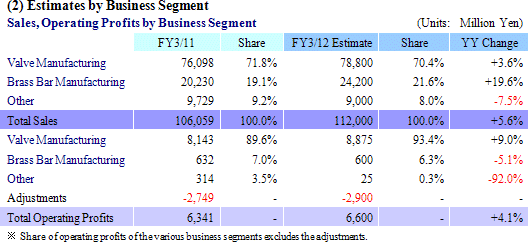 Valve Manufacturing Business
The impact of the earthquake and tsunami disaster is expected to raise the risk of stagnant economic activities during the first half of the fiscal year in Japan. And while an increase in demand from the recovery efforts may eventually contribute positively to the Japanese economy, KITZ assumes that the economy in the second half of the year will remain flat from the previous year's level due to numerous uncertainties surrounding the overall economy. At the same time, strong growth is expected in the economies of various countries throughout Asia along with relatively brisk economic activity in the United States.With regards to sales, orders from sales distributors have been increasing as they endeavor to increase their inventory levels in the wake of the earthquake and tsunami disaster. However this ad hoc demand has not been factored into the Company's earnings estimates. At the same time overseas sales to Asian markets are expected to expand, along with expectations of stronger demand driven by recoveries in economies in North America and an economic bottoming in Europe. 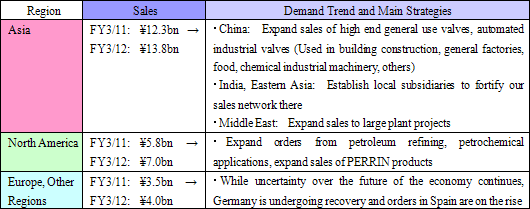 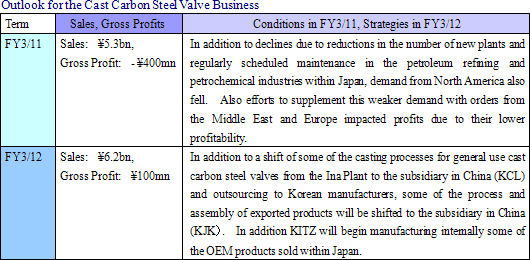 Also, the Group subsidiaries in Thailand, Taiwan and so on will change their accounting period (The fiscal year will be shortened to 10 months.) and sales and operating profit are expected to be reduced by this change by ¥2.4 billion and ¥150 million respectively. Brass Bar Manufacturing Business
Production of brass bars in the overall market is expected to rise by 3% year-over-year to 200,000 tons, and KITZ's assumption for the average price of copper is ¥820,000 per ton (¥740,000 per ton in the previous term). A 9% year-over-year increase in production and sale of KITZ Metal Works Corporation to 3,500 tons and a rise in product pricing accompanying stronger market prices of copper are expected to contribute to a 19.6% year-over-year growth in this segment's sales to ¥24.2 billion. However increases in fixed costs arising from growth in the number of employees are expected to reduce operating profit by 5.1% year-over-year to ¥600 million. KITZ will also pursue a strategy of growing sales of special and fine materials and other higher value added products and increasing its share of total sales from 20% to 23%.
Other
Sales and operating profit of the fitness club operations are expected to decline by ¥370 and ¥130 million year-over-year respectively, of which stoppage of operations at the Sendai and Mito facilities due to the Eastern Japan Earthquake and Tsunami disaster is expected to depress sales and operating profits by ¥370 and ¥160 million respectively. At the same time sales and operating profits of the hotel operations are expected to fall by ¥290 and ¥90 million year-over-yeear respectively, of which cancellations of reservations and restraint in travel by large groups and individuals due to the earthquake and related disasters is expected to depress sales and operating profits by ¥300 and ¥120 million respectively.
|
| Conclusions |
|
Disclaimer
This report is intended solely for information purposes, and is not intended as a solicitation to invest in the shares of this company. The information and opinions contained within this report are based on data made publicly available by the Company, and comes from sources that we judge to be reliable. However we cannot guarantee the accuracy or completeness of the data. This report is not a guarantee of the accuracy, completeness or validity of said information and or opinions, nor do we bear any responsibility for the same. All rights pertaining to this report belong to Investment Bridge Co., Ltd., which may change the contents thereof at any time without prior notice. All investment decisions are the responsibility of the individual and should be made only after proper consideration.Copyright(C) 2011, All Rights Reserved by Investment Bridge Co., Ltd. |

